Once an automotive oddity, the Toyota Prius has become a household name after two decades of saving planet Earth.
Like Kleenex, Thermos or Jell-O, it’s morphed into something of a genericized trademark. When people think of hybrids, the Prius is probably top of mind.
Back in the 1990s, engineers figured out that if they married a gasoline engine to an electric motor and battery pack, they could create more than just a polygamous drivetrain, they could create something dramatically more efficient than a standard internal-combustion-powered vehicle, one that’s also able to cross continents without being tethered to an electrical outlet.
Throw breeze-cheating aerodynamics into the mix and Prius delivered borderline-unbelievable fuel economy. Not surprisingly, over the past 20 years, this nameplate has saved untold gallons of gasoline, something it continues to do today, especially in plug-in form.
The “Prime” Directive
Further increasing efficiency, the 2017 Prius Prime takes Toyota’s famous Hybrid Synergy Drive technology to the next level. A more efficient engine, larger battery pack and focus on light-weighting has resulted in a car that’s incredibly economical, even by Prius standards.
Get the Flash Player to see this player.
According to the U.S. EPA, this machine is rated at 133 MPGe combined, that’s miles per gallon equivalent, a way of relating stored electrons to the energy contained in a gallon of gasoline. With the internal-combustion engine in play, this car averages a still incredible 54 MPG. These figures far exceed what rival models can muster. The Chevy Volt for instance, an arch nemesis, clocks in at just 106 and 42, respectively. They also top the standard Prius, which stickers at 54 city, 50 highway and 52 MPG combined.
But the figures printed on window stickers are one thing, real-world driving is quite another, though shockingly the Prime dominates here as well. Tooling around town with a depleted battery pack (read: running on gasoline) and doing absolutely nothing special I managed to average a claimed 57 miles per gallon. Believe it? Me neither.
So, I reset the fuel economy meter and guess what? It spat the same number back at me after a short time, suggesting this car really is that efficient, or it’s at least a consistent liar. Truth be told, I believe the numbers it lists.
Secret Sauce (It’s Not Thousand Island)
Delivering these figures is a highly optimized drivetrain with a 1.8-liter engine at its heart. Flying solo, this four-cylinder unit delivers 95 horsepower and 105 lb-ft of torque. A major point of pride here is thermal efficiency, which the company claims is 40 percent, a significant improvement compared to most internal-combustion engines, which generally fall in the range of 25 to 30.
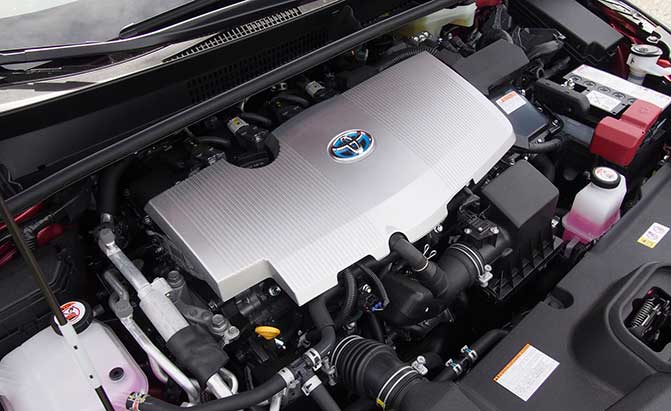
Helping provide a total system output of 121 ponies is a pair of permanent magnet electric motors. For the first time in a Toyota hybrid, both the drive motor and generator can propel the vehicle thanks to the addition of a new one-way clutch.
An electronically continuously variable automatic transmission routes torque to the pavement, providing a mostly seamless experience.
The other major part of this car’s drivetrain is an 8.8 kWh lithium-ion battery pack, more than twice as large as the old Prius Plug-In’s. When fully charged, it provides an estimated electric-only range of 25 miles, which, to be fair, is less than half of what the Volt can deliver, though its battery clocks in at a whopping 18.4 kWh. Still, the Prime’s electric-only range should be good enough for a large number commuters in the U.S.
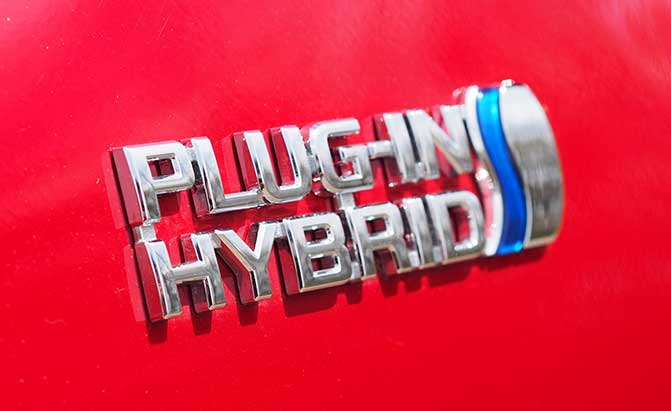
Recharge times are par for the EV course, measuring roughly five-and-a-half hours when hooked up to standard household power. However, if you’ve got access to a 240-volt outlet that figure falls to about two hours. Factor in the 11.3-gallon (43-liter) gasoline tank and the Prius Prime should be able to travel 640 miles (1,030 kilometers) on a single fill-up.
Efficiency at all Cost
Thanks primarily to its larger battery, the Prime is about 290 pounds heavier than the lightest non-plug-in Prius, clocking in at about 3,365 pounds.
Helping offset some of this mass, the hatch is made of carbon fiber-reinforced plastic, making it fingertip light to open or close. Ultra-efficient LED headlamps also reduce drag, as does the climate-control system, which employs a heat pump instead of a conventional HVAC arrangement. Operating kind of like an air conditioner in reverse, heat pumps can be drastically more efficient than resistance-type heaters. They can also run when the internal-combustion engine is shut off.
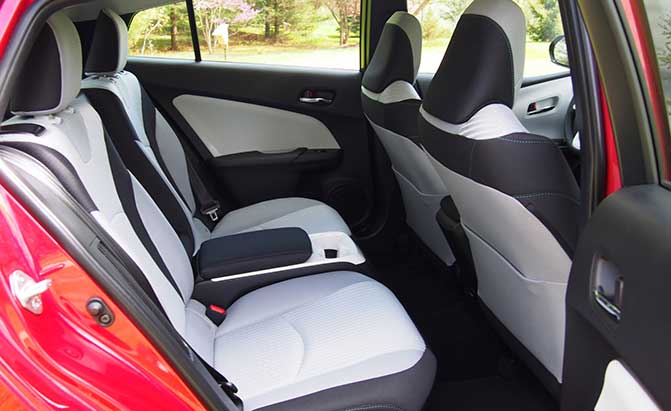
While slightly less painful to gaze upon than your standard Prius, the Prime is never going to win any beauty contests. Calling it more attractive than its sibling is like a prisoner boasting about having the fewest life sentences. What difference does it make?
But if there is one praiseworthy design element on this car it’s probably the curved rear glass. Gently dipped in the center, it catches your eye, especially since it flows nicely into the truncated decklid. This is an interesting and unique embellishment that also helps improve aerodynamics.
You can decide for yourself if this car is attractive; at this point, I’ve concluded that the Prius is simply weird for weirdness’ sake, a theme that, for better or worse, continues inside. The Prime’s cabin is airy and nicely finished, but it’s a carnival of surfaces, swoops, trim types and colors.
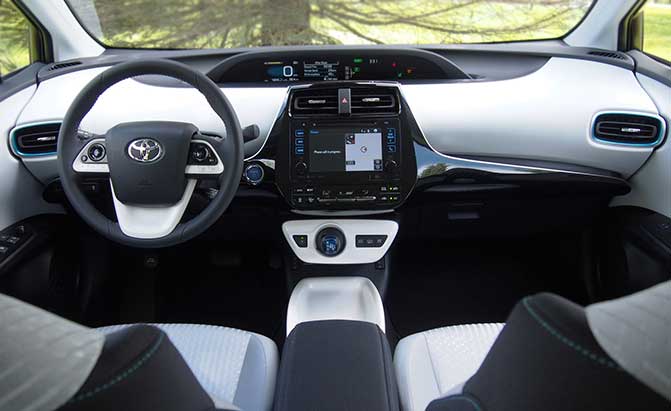
In our test car, the soft, white material running along the doors and dashboard contrasts sharply with charcoal-colored accents, which in turn look odd next to the piano-black trim, gray fabric on the seats and teal accented air vents. Also, why are there shiny white elements on the center console and steering wheel? It makes them look like bathroom fixtures!
Making up for some of this, the build quality is flawless and all the switchgear has a high-quality feel. Up front, the seats are broad and flat, American-sized if you will. There’s also tons of headroom, probably enough for LeBron James to wear a sombrero. Outward visibility is mostly unobstructed.
The Prime’s back seat offers plenty of space for knees, though the headroom comes up short. Six-footers can’t sit up straight without their coiffures getting mussed up. The prime has room for four people, two up front and another duet in the back.
The Drive
This car delivers a mostly smooth and quiet drive, with a supple if somewhat tippy-feeling ride. Basically it behaves like a standard Prius that’s a bit heavier, which should be no surprise since that’s basically what it is.
In electric-only mode, a gentle whirr is basically all you hear, though the combustion engine is appreciably louder, thrashing away while going about its business. Acceleration is slow but not dangerously so, with the car reaching 60 miles an hour in an estimated 10 seconds. Thanks to an abundance of low-speed torque the Prime seems much fleeter from a getaway than you might expect.
When it’s time to change direction, the Prime is completely unwilling to play. Body roll is noticeable and the eco-friendly tires inspire little confidence. But this car’s worst dynamic shortcoming is steering that’s deader than the Roman Empire; it’s too light and feels completely synthetic.
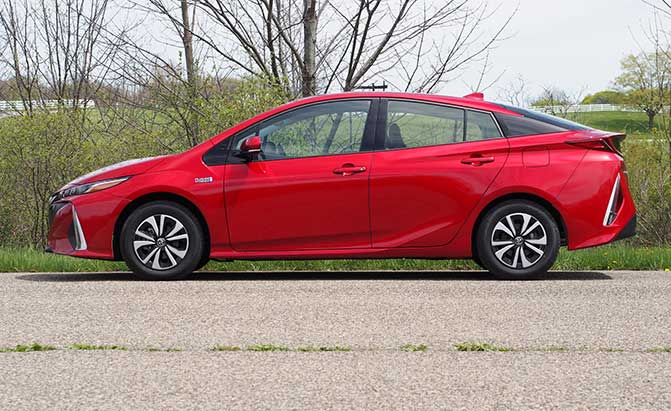
Another questionable engineering choice is the tilt-and-telescopic steering column. Its range of motion is so limited, engineers shouldn’t have even bothered including one since it’s basically useless, moving but a few millimeters in each direction.
Taking the stress out of motoring, Toyota Safety Sense P is standard. This includes popular features like pre-collision braking, pedestrian detection, lane-departure warning, adaptive cruise control, automatic high beams and more.
The Prius Prime offers three separate driving modes, Normal, for everyday use; Power, which is ideal for traversing mountainous terrain; and Eco, the setting intended for use in stop-and-go conditions to maximize efficiency.
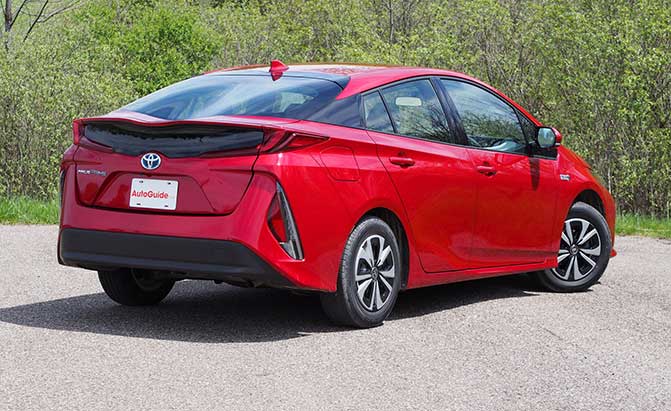
In addition to this, the hybrid system has three different modes. EV runs the car on electrical power when there’s enough juice in the battery. The EV Auto setting is designed for situations where more power is required. It runs the engine and electric motor simultaneously for quick passing or hill climbing. Curiously, in either of these modes, the engine can run in certain situations, like when you’re going faster than 84 miles an hour, require more power, the temperatures are extreme or if the windshield defogger is on.
Finally, there’s HV mode, which allows the Prime to operate like a standard hybrid, automatically switching between electric and internal-combustion as needed. This setting is recommended for highway driving to conserve battery power, which is best reserved for urban driving.
The Verdict: 2017 Toyota Prius Prime Plug-In Review
Like the original Prius, Prime is plenty weird, but it’s also supremely economical. For drives that want unbeatable reliability and efficiency, this is probably the car to get, even if rivals like the Chevy Volt offer greater electric-only range and more, shall we say, conventional styling.
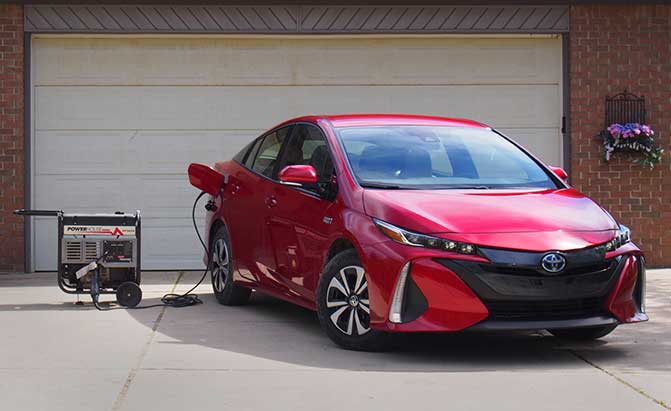
Excluding any rebates, base price for one of these plug-in fuel-sippers is $27,985, including $885 in delivery charges. That overall price is hard to argue with, especially compared to the standard Prius, which kicks off at $24,360, a difference of less than four grand. Refreshingly simple, our test model checked out at an exceedingly reasonable $28,380, with its only extra being glittery red paint for an additional $395. That makes this road-going spaceship an incredible value, especially since it can get better than 50 miles per gallon without even trying. Because of this, in 20 years Prime will become synonymous with unbelievable since that’s what this car’s efficiency is.
Discuss this story on our Toyota Forum


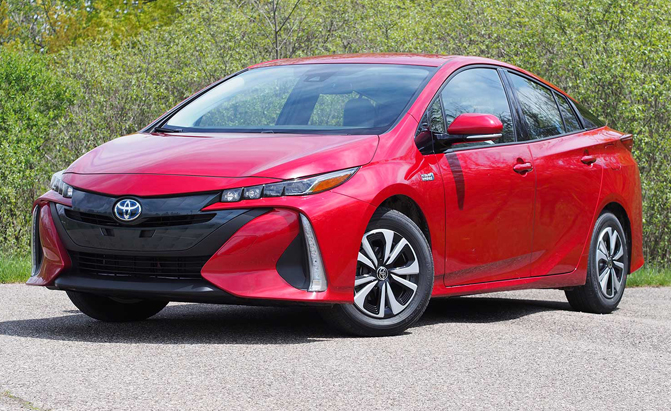
Leave a Reply